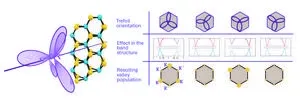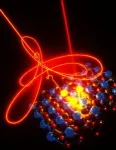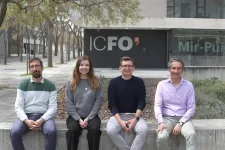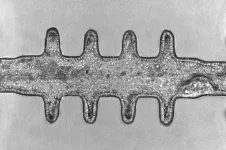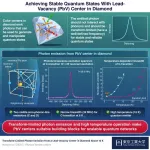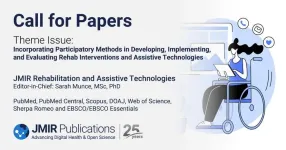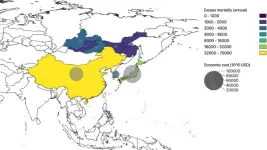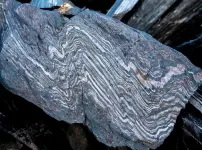(Press-News.org) Tumors actively prevent the formation of immune responses by so-called cytotoxic T cells, which are essential in combating cancer. Researchers at the Technical University of Munich (TUM) and the Ludwig-Maximilians-Universität München (LMU) Hospital have now uncovered for the first time how this exactly happens. The study in the journal Nature provides rationales for new cancer immunotherapies and could make existing treatments more effective. A second paper in Nature confirms the findings.
In cancer, tumors often impair the body's immune response. For example, they can prevent immune cells from perceiving cancer cells as a threat or render them inactive. Immunotherapies aim to overcome these mechanisms and stimulate the immune system, in particular the T cells. However, such therapies do not work for a large number of cancer patients. Researchers around the world are looking for the causes and new counter-strategies.
Messenger substance stops effector development of T cells in tumors
A team led by Dr. Jan Böttcher, research group leader at the Institute of Molecular Immunology at TUM, and Prof. Sebastian Kobold, Deputy Director of the Department of Clinical Pharmacology at LMU Klinikum München, has now discovered that tumors use a messenger substance to influence immune cells in an early phase of the immune response. Many cancer cells show increased secretion of the messenger substance prostaglandin E2. The researchers were able to show that prostaglandin E2 binds to EP2 and EP4, two receptors on the surface of certain immune cells.
These so-called stem-like T cells migrate from other areas of the body into the tumor. If the immune response is successful, they multiply in the tumor and develop into cytotoxic T cells that attack the cancer. "This whole process is strongly limited when tumors secrete prostaglandin E2 and this factor binds to EP2 and EP4 receptors," says Jan Böttcher. "The T cell response collapses and the tumor can progress." If the researchers prevented the interaction of messenger substance and receptor in tumor models, the immune system was able to fight tumors effectively.
Current therapies address a later point of the immune response
"We have discovered a mechanism that influences the body's immune response in a crucial phase," says Jan Böttcher. "Many tumors prevent the stem-like T cells from generating cytotoxic T cells in the tumor that could attack the cancer."
Current immunotherapies aim to prevent the cancer from switching off immune responses at a later phase. Checkpoint inhibitor therapies, for example, aim to release the blockade of fully differentiated cytotoxic T cells and "switch them back on". Before the dreaded T cell exhaustion sets in, which other researchers are trying to prevent, differentiated T cells must also be present.
Increase the effectiveness of existing therapies
"Current treatment approaches would probably be more effective if the effects of prostaglandin E2 on stem-like T cells is blocked to enable their unhindered differentiation within tumor tissue," says Sebastian Kobold.
This similarly applies to recent approaches that rely on the protein IL-2 to stimulate T cells. The current study shows that as soon as the prostaglandin E2 binds to the two receptors, T cells can no longer respond to IL-2. "We suspect that even the body's own IL-2 signals may be sufficient to enable T cells to successfully fight cancer once the effects of prostaglandin E2 have been stopped," says Sebastian Kobold.
Second study in "Nature" confirms results
A second research publication in Nature investigates the effects of prostaglandin E2 on the immune system. For this study, the authors, researchers from the University Hospital of Lausanne, collaborated with the Munich team. In their laboratory, they among other things examined T cells from human tumor tissue. When they blocked the release of prostaglandin E2 in cancer tissue, the T cells showed better expansion and were thus able to fight human cancer cells more effectively.
Search for counter-strategies begins
"We now have a concrete starting point for significantly improving immunotherapies," says Jan Böttcher. "Researchers around the world must now develop strategies to overcome the tumors' defense. We need to stop the effects of prostaglandin E2 - either by preventing tumors from producing the molecule or by making immune cells resistant to it."
Publications:
S.B. Lacher, J. Dörr, G. P. de Almeida, J. Hönninger, F. Bayerl, A. Hirschberger, A.-M. Pedde, P. Meiser, L. Ramsauer, T.J. Rudolph, N. Spranger, M. Morotti, A. J. Grimm, S. Jarosch, A. Oner, L. Gregor, S. Lesch, S. Michaelides, L. Fertig, D. Briukhovetska, L. Majed, S. Stock, D.H. Busch, V.R. Buchholz, P.A. Knolle, D. Zehn, D. Dangaj Laniti, S. Kobold, J.P. Böttcher, "Prostaglandin E2 curtails interleukin-2-dependent effector expansion from tumour infiltrating stem-like CD8+ T cells to promote cancer immune escape". Nature (2024). DOI: 10.1038/s41586-024-07254-x
M. Morotti, A.J. Grimm, H. Carrasco Hope, M. Arnaud, M. Desbuisson, N. Rayroux, D. Barras, M. Masid, B. Murgues, B.S. Chap, M. Ongaro, I.A. Rota, C. Ronet, A. Minasyan, J. Chiffelle, S.B. Lacher, . Bobisse, C. Murgues, E. Ghisoni, K. Ouchen, R. Bou Mjahed, F. Benedetti, N. Abdellaoui, R. Turrini, P.O. Gannon, K. Zaman, P. Mathevet, L. Lelievre, I. Crespo, M. Conrad, G. Verdeil, L. E. Kandalaft, J. Dagher, J. Corria-Osorio, M.-A. Doucey, P.-C. Ho, A. Harari, N. Vannini, J.P. Böttcher, D. Dangaj Laniti, and G. Coukos. "PGE2 inhibits TIL expansion by disrupting IL-2 signalling and metabolism". Nature (2024). DOI: 10.1038/s41586-024-07352-w.
Further information:
The study was funded by the Elite Network of Bavaria, the German Research Foundation (DFG), the Wilhelm Sander Foundation, and the International Doctoral Program i-Target: Immunotargeting of Cancer.
Additional material for media outlets:
Photos for download: https://mediatum.ub.tum.de/1740626
This media release on tum.de: https://www.tum.de/en/news-and-events/all-news/press-releases/details/tumor-cells-evade-the-immune-system-early-on
Subject matter expert:
Dr. Jan Böttcher
Technical University of Munich
Institute of Molecular Immunology
Tel. +49 89 4140 4453
j.boettcher@tum.de
www.imi.med.tum.de
TUM Corporate Communications Center contact:
Paul Hellmich
Media Relations
Tel. +49 (0) 89 289 22731
presse@tum.de
www.tum.de
END
Tumor cells evade the immune system early on: Newly discovered mechanism could significantly improve cancer immunotherapies
2024-04-24
ELSE PRESS RELEASES FROM THIS DATE:
Children with skin diseases suffer stigma, bullying and depression
2024-04-24
· 73% of children with skin disease experience stigma and poor quality of life
· ‘Chronic skin conditions can be tremendously life-altering’
· Shame during childhood can affect them throughout their lives, dermatologist says
CHICAGO --- The majority of children and teens with chronic skin diseases such as acne, eczema, psoriasis, alopecia areata (hair loss) and vitiligo (pigment loss) feel stigmatized by peers for their condition and are sometimes bullied, reports a new Northwestern Medicine study. As a result, these children have a ...
A novel universal light-based technique to control valley polarization in bulk materials
2024-04-24
Electrons inside solid materials can only take certain values of energy. The allowed energy ranges are called “bands” and the space between them, the forbidden energies, are known as “band-gaps”. Both of them together constitute the “band structure” of the material, which is a unique characteristic of each specific material.
When physicists plot the band structure, they usually see that the resulting curves resemble mountains and valleys. In fact, the technical term for a local energy maximum or minimum in the bands is called a “valley”, and the field which studies and exploits how electrons in the material ...
Vast DNA tree of life for flowering plants revealed by global science team
2024-04-24
Images
The most up-to-date understanding of the flowering plant tree of life is presented in a new study published today in the journal Nature by an international team of 279 scientists, including three University of Michigan biologists.
Using 1.8 billion letters of genetic code from more than 9,500 species covering almost 8,000 known flowering plant genera (ca. 60%), this achievement sheds new light on the evolutionary history of flowering plants and their rise to ecological dominance on Earth.
Led by scientists at the Royal Botanic Gardens, Kew, the research team believes ...
Mini-colons revolutionize colorectal cancer research
2024-04-24
As our battle against cancer rages on, the quest for more sophisticated and realistic models to study tumor development has never been more critical. Until now, research has relied on animal models and simplified cell culture methods, which are valuable but cannot fully capture the complex interplay of factors involved in tumor development.
Even newer, more advanced models for studying cancer, such as organoids – tiny, lab-grown versions of organs – do not faithfully replicate the cell behaviors and tissue architectures seen in actual tumors.
This gap has significantly hindered our understanding ...
Lead-vacancy centers in diamond as building blocks for large-scale quantum networks
2024-04-24
Much like how electric circuits use components to control electronic signals, quantum networks rely on special components and nodes to transfer quantum information between different points, forming the foundation for building quantum systems. In the case of quantum networks, color centers in diamond, which are defects intentionally added to a diamond crystal, are crucial for generating and maintaining stable quantum states over long distances.
When stimulated by external light, these color centers in diamond emit photons carrying information about their internal electronic states, especially the spin states. The interaction between the emitted photons and the ...
JMIR Rehabilitation and Assistive Technologies announces theme issue on participatory methods in rehabilitation research
2024-04-24
JMIR Publications invites submissions to a new theme issue titled “Incorporating Participatory Methods in Developing, Implementing, and Evaluating Rehab Interventions and Assistive Technologies” in its premier, open access journal JMIR Rehabilitation and Assistive Technologies (JRAT).
JRAT is a peer-reviewed journal indexed in PubMed and PubMed Central, SCOPUS, DOAJ, Web of Science, Sherpa Romeo, and EBSCO and EBSCO Essentials. This theme issue aims to showcase research that actively engages patients, caregivers, and other stakeholders (knowledge users) ...
SwRI’s Dr. Marc Janssens recognized for role in establishing cone calorimeter fire testing
2024-04-24
SAN ANTONIO — April 24, 2024 — Southwest Research Institute’s Dr. Marc Janssens was named a “DiNenno Prize Laureate” for his role in the widespread adoption of the cone calorimeter, a fire-testing tool that accurately measures heat release and material flammability. The National Fire Protection Association® recognized the cone calorimeter with the 2024 Philip J. DiNenno Prize for its lasting impact on fire safety. Dr. Vytenis Babrauskas, a co-recipient of the prize, developed the cone ...
Modeling broader effects of wildfires in Siberia
2024-04-24
As wildfires in Siberia become more common, global climate modeling estimates significant impacts on climate, air quality, health, and economies in East Asia and across the northern hemisphere.
The global effects of increasing wildfires in Siberia have been modeled by researchers at Hokkaido University and colleagues at the University of Tokyo and Kyushu University. The results, published in the journal Earth’s Future, suggest significant and widespread effects on air quality, climate, health, and economics under the most extreme wildfire scenarios.
The authors performed global numerical simulation experiments to evaluate how the increased intensity of wildfires ...
Researchers find oldest undisputed evidence of Earth’s magnetic field
2024-04-24
A new study, led by the University of Oxford and MIT, has recovered a 3.7-billion-year-old record of Earth’s magnetic field, and found that it appears remarkably similar to the field surrounding Earth today. The findings have been published today in the Journal of Geophysical Research.
Without its magnetic field, life on Earth would not be possible since this shields us from harmful cosmic radiation and charged particles emitted by the Sun (the ‘solar wind’). But up to now, there has been no reliable date for when the modern magnetic field was first established.
In the new study, the researchers examined ...
Eric and Wendy Schmidt announce 2024 Schmidt Science Fellows
2024-04-24
Eric and Wendy Schmidt Announce 2024 Schmidt Science Fellows
32 exceptional early career researchers will tackle ambitious interdisciplinary science projects
The seventh cohort of the interdisciplinary program, an initiative of Schmidt Sciences, will advance research in areas ranging from healthcare and the environment to advanced materials and robotics
The 2024 Fellows, representing 17 nationalities from 26 nominating institutions across North America, Europe, and Asia, will also benefit from bespoke ...

